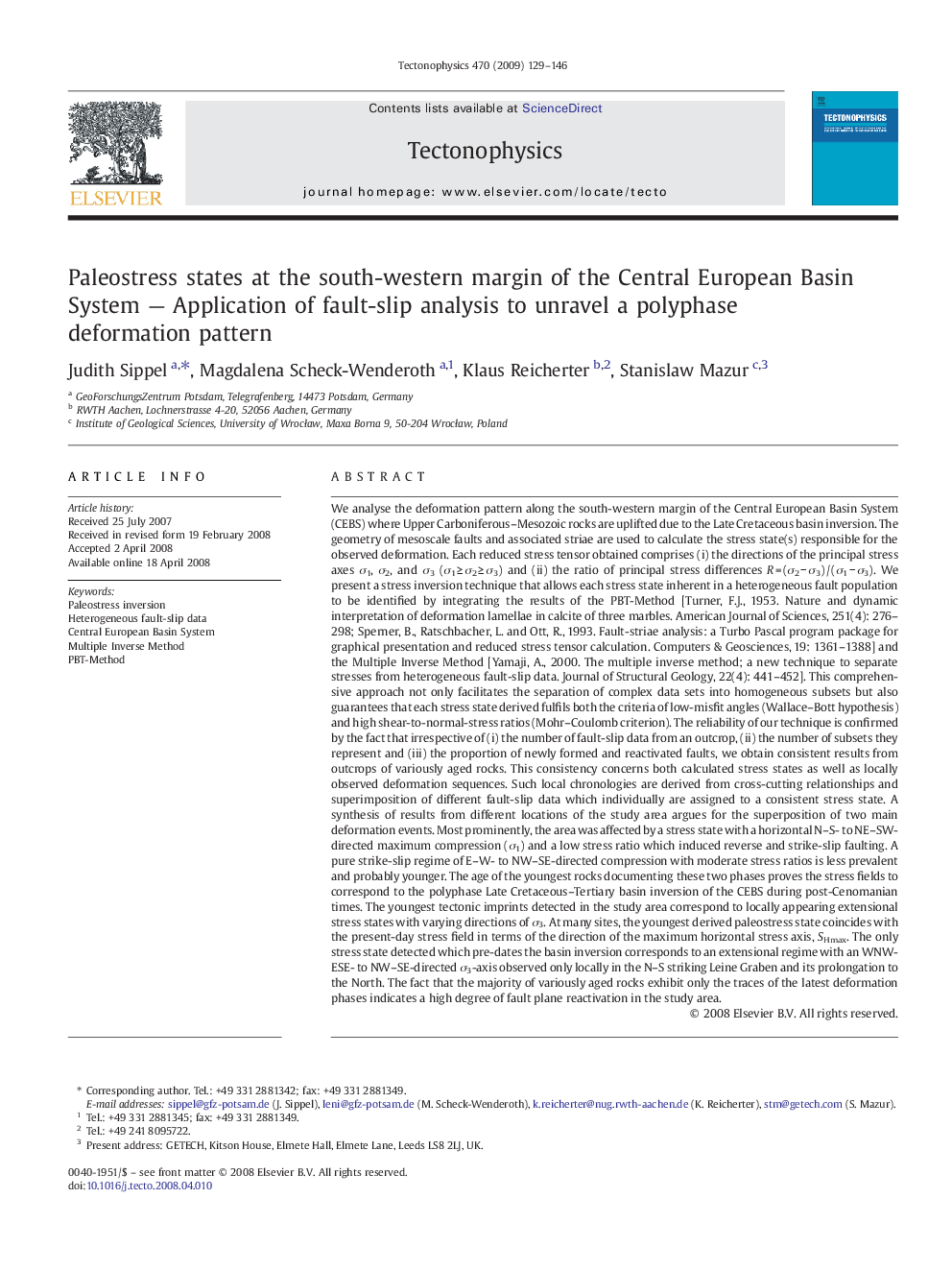| کد مقاله | کد نشریه | سال انتشار | مقاله انگلیسی | نسخه تمام متن |
|---|---|---|---|---|
| 4694213 | 1636894 | 2009 | 18 صفحه PDF | دانلود رایگان |

We analyse the deformation pattern along the south-western margin of the Central European Basin System (CEBS) where Upper Carboniferous–Mesozoic rocks are uplifted due to the Late Cretaceous basin inversion. The geometry of mesoscale faults and associated striae are used to calculate the stress state(s) responsible for the observed deformation. Each reduced stress tensor obtained comprises (i) the directions of the principal stress axes σ1, σ2, and σ3 (σ1 ≥ σ2 ≥ σ3) and (ii) the ratio of principal stress differences R = (σ2 − σ3) / (σ1 − σ3). We present a stress inversion technique that allows each stress state inherent in a heterogeneous fault population to be identified by integrating the results of the PBT-Method [Turner, F.J., 1953. Nature and dynamic interpretation of deformation lamellae in calcite of three marbles. American Journal of Sciences, 251(4): 276–298; Sperner, B., Ratschbacher, L. and Ott, R., 1993. Fault-striae analysis: a Turbo Pascal program package for graphical presentation and reduced stress tensor calculation. Computers & Geosciences, 19: 1361–1388] and the Multiple Inverse Method [Yamaji, A., 2000. The multiple inverse method; a new technique to separate stresses from heterogeneous fault-slip data. Journal of Structural Geology, 22(4): 441–452]. This comprehensive approach not only facilitates the separation of complex data sets into homogeneous subsets but also guarantees that each stress state derived fulfils both the criteria of low-misfit angles (Wallace–Bott hypothesis) and high shear-to-normal-stress ratios (Mohr–Coulomb criterion). The reliability of our technique is confirmed by the fact that irrespective of (i) the number of fault-slip data from an outcrop, (ii) the number of subsets they represent and (iii) the proportion of newly formed and reactivated faults, we obtain consistent results from outcrops of variously aged rocks. This consistency concerns both calculated stress states as well as locally observed deformation sequences. Such local chronologies are derived from cross-cutting relationships and superimposition of different fault-slip data which individually are assigned to a consistent stress state. A synthesis of results from different locations of the study area argues for the superposition of two main deformation events. Most prominently, the area was affected by a stress state with a horizontal N–S- to NE–SW-directed maximum compression (σ1) and a low stress ratio which induced reverse and strike-slip faulting. A pure strike-slip regime of E–W- to NW–SE-directed compression with moderate stress ratios is less prevalent and probably younger. The age of the youngest rocks documenting these two phases proves the stress fields to correspond to the polyphase Late Cretaceous–Tertiary basin inversion of the CEBS during post-Cenomanian times. The youngest tectonic imprints detected in the study area correspond to locally appearing extensional stress states with varying directions of σ3. At many sites, the youngest derived paleostress state coincides with the present-day stress field in terms of the direction of the maximum horizontal stress axis, SHmax. The only stress state detected which pre-dates the basin inversion corresponds to an extensional regime with an WNW-ESE- to NW–SE-directed σ3-axis observed only locally in the N–S striking Leine Graben and its prolongation to the North. The fact that the majority of variously aged rocks exhibit only the traces of the latest deformation phases indicates a high degree of fault plane reactivation in the study area.
Journal: Tectonophysics - Volume 470, Issues 1–2, 17 May 2009, Pages 129–146